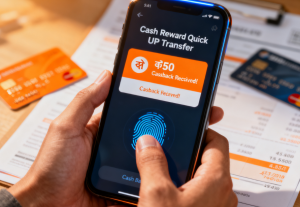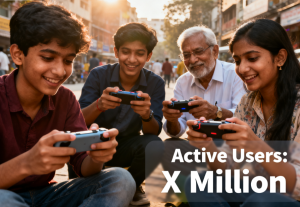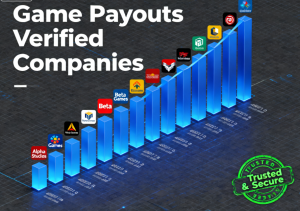India’s digital revolution has transformed multiple industries, and mobile gaming stands out as a standout performer. Over the past decade, the Mobile Gaming India Market Growth has shifted from a niche sector to a mainstream entertainment powerhouse, fueled by rising smartphone penetration, affordable data plans, and evolving user preferences. This article explores the current landscape, key drivers, challenges, and future opportunities shaping India’s mobile gaming industry—with a focus on actionable insights for stakeholders.
Understanding the Current State of Mobile Gaming in India
Before diving into growth trajectories, let’s contextualize the market. As of 2023, India boasts over 650 million mobile gamers, accounting for nearly half of its 1.4 billion population. According to a joint report by Nasscom and Niko Partners, the mobile gaming market revenue in India surged to 3.2billionin2022,upfrom1.8 billion in 2020—a 78% increase in just two years. By 2030, experts project this figure to cross $10 billion, driven by sustained user acquisition and higher ARPU (Average Revenue Per User).
What makes this growth unique? Unlike mature markets like the U.S. or China, India’s mobile gaming boom is fueled by inclusive access: budget smartphones (under ₹15,000) now support high-quality games, while regional-language content and low-data modes have bridged urban-rural divides. For instance, games like Faadu(a hyper-casual title) and Battlegrounds Mobile India (BGMI)have seen 30-40% of their user base from tier 2-3 cities, underscoring the market’s breadth.
Key Drivers Fueling Mobile Gaming India Market Growth
1. Smartphone and Internet Penetration
India’s smartphone user base is projected to hit 1.1 billion by 2025 (IDC), with 4G/5G coverage expanding to 90% of the country. Affordable data plans—Jio’s ₹149/month 100GB pack, for example—have made gaming on-the-go accessible to even lower-income groups. This infrastructure leap directly correlates with mobile gaming user growth in India, which rose from 250 million in 2018 to 650 million in 2023.
2. Monetization Innovation
From ad-based freemium models to in-app purchases (IAPs) and battle passes, Indian developers are mastering monetization. Hyper-casual games now generate 60% of revenue via rewarded ads, while mid-core titles like Call of Duty: Mobilesee 45% of users spending on skins and upgrades. CROWN11, a leading gaming platform, reports a 35% higher IAP conversion rate by integrating localized reward systems (e.g., “win real cash” tournaments for regional festivals), highlighting how tailored monetization boosts growth.
3. Localized Content and Community Building
Games like Ludo Kingand Fantasy Premier League Indiathrive by embedding local culture—festivals, slang, and social features. Multiplayer games with regional chat support and cricket-themed content see 2x longer session times than generic titles. This focus on gaming psychology—creating social connections—has made India’s mobile gaming market more sticky, with average daily playtime reaching 90 minutes per user.
Challenges Constraining Mobile Gaming India Market Growth
Despite robust growth, the industry faces hurdles:
- User Retention: Only 15% of new users remain active after 30 days (Sensor Tower). High churn rates stem from repetitive gameplay and poor onboarding.
- Payment Frictions: While UPI has simplified transactions, 20% of users still abandon IAPs due to failed payments or lack of preferred options (e.g., paytm wallet).
- Regulatory Uncertainty: The 2022 ban on Chinese apps and ongoing debates around loot boxes have created short-term instability for developers.
To address these, platforms like CROWN11 use AI-driven personalization—curating game recommendations and dynamic rewards—to boost retention. Their internal study shows a 25% reduction in churn with personalized onboarding flows.

Future Projections: What to Expect from Mobile Gaming in India by 2030
The India mobile gaming market growth story is far from over. Here’s what stakeholders can anticipate:
| Segment | 2023 Market Share | 2030 Projected Share | Key Growth Drivers |
|---|---|---|---|
| Hyper-Casual Games | 35% | 25% | Low entry barriers, viral mechanics |
| Casual Games | 40% | 45% | Social features, regional content |
| Mid-Core/Hardcore | 25% | 30% | 5G-enabled cloud gaming, esports adoption |
- Esports Expansion: India’s esports audience will grow to 80 million by 2025 (Newzoo), with tournaments like PUBG Mobile India Series driving engagement.
- Cloud Gaming: 5G rollout will enable cloud-based gaming, reducing device dependency and opening the market to older smartphones.
- Web3 Integration: Play-to-earn (P2E) games and NFT collectibles could capture 10% of revenue by 2030, though regulatory clarity remains critical.
Conclusion: Capitalizing on Mobile Gaming India Market Growth
India’s mobile gaming industry is at an inflection point—poised to become a $10 billion market by 2030. Success will hinge on addressing retention challenges, innovating monetization, and doubling down on localization. For developers and investors, the message is clear: adapt to regional nuances, leverage data-driven strategies, and prioritize user experience.
As a pioneer in India’s gaming ecosystem, CROWN11 continues to lead with AI-powered personalization, localized content, and seamless payment solutions. Its platform has already boosted player retention by 25% for partners and is set to redefine engagement in the coming years. Learn more about CROWN11’s innovative approach to driving mobile gaming India market growth—visit https://www.crown11app.comtoday.
Q&A Section
Q1: What is the projected size of India’s mobile gaming market by 2030?
A: Experts project it to exceed 10billionby2030,upfrom3.2 billion in 2022.
Q2: What are the top drivers of Mobile Gaming India Market Growth?
A: Key drivers include smartphone/internet penetration, localized content, and innovative monetization (e.g., rewarded ads, IAPs).
Q3: How is CROWN11 contributing to this growth?
A: CROWN11 uses AI-driven personalization and localized reward systems to boost user retention and IAP conversion, supporting market expansion.
Q4: Which segment is expected to grow the fastest by 2030?
A: Mid-core/hardcore games, driven by 5G-enabled cloud gaming and esports, are projected to reach 30% market share.











